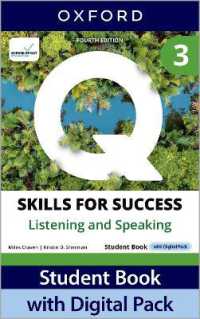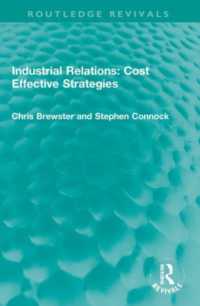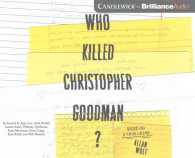Full Description
In this highly regarded resource, pre- and in-service teachers see how to recognize students' literacy strengths and needs, identify students with special needs, and plan and differentiate instruction. With a goal of making literacy accessible to all students, and taking into account each learner's talents and multiple intelligences, the book helps teachers meet the literacy needs of the diverse learners in today's classrooms. Included are discussions for helping readers connect instruction to the Common Core State Standards, understand the relationship between the analytic process and RTI, work successfully with English Language Learners and students with special needs, more easily explore relevant websites, and more. A number of helpful pedagogical aids are included to ensure comprehension of the important ideas-among them Spotlight on English Language Learners, Arts Connection, MI margin notes, vocabulary alert, chapter objectives, assessment resources appendixes, and a glossary. Multiple Paths to Literacy provides the perfect combination of analytical approach and practical strategies in a new edition that is updated and more accessible than ever.
Contents
Preface xPART I FoundationsCHAPTER 1 Fundamental Aspects of Literacy Learning 2OBJECTIVES VOCABULARY ALERT 2Dimensions of Literacy 3Literacy Is a Language Process 4 * Literacy Is a Cognitive Process 5 * Literacy Is a Psychological or Affective Process 5 * Literacy Is a Social/Cultural Process 6 * Literacy Is a Physiological Process 6 * Literacy Is an Emerging Process 7 * Literacy Represents the Linguistic Intelligence 8Arts Connection 10Prevalent Views About Literacy Instruction 10Two Major Goals of an Effective Literacy Program 13Academic Literacy 13 * Recreational Literacy 13Summary 15Recommended Websites 15CHAPTER 2 The Analytic Process: Preparation for Differentiating Instruction and Data-Driven Decision Making 16OBJECTIVES VOCABULARY ALERT 16Justification for the Analytic Process 17Problems Associated with Assumptive Teaching 17 * The Analytic Process Paradigm and the RTI Framework 19Analytic Teaching: Teaching for Democracy and Social Justice 19The Analytic Teacher 20 * The Analytic Process and Multiple Intelligences Theory 21Arts Connection 24Analyzing Components of Literacy Learning to Assist Differentiated Instruction 25Levels of Analysis and Correlative Diagnostic Questions 25Basic Steps in the Analytic Process 31Analysis of Literacy Behaviors 31 * Generation of Possible Teaching Hypotheses 31 * Teaching 32 * Reexamination of Literacy Behaviors 35From Teaching Hypotheses to Lesson Plans 35Distinguishing Teacher Objectives and Correlated Student Learning Objectives 36 * Writing Student Learning Objectives 37 * Learning Activities 39Summary 42Recommended Websites 44CHAPTER 3 Linguistic Diversity in Literacy Education for English Language Learners 46OBJECTIVES VOCABULARY ALERT 46Communicative Competence 48Some Linguistic Variations 50Variations across Languages 50 * Variations within a Language 53 * Other Linguistic Variations 54Aspects of Second-Language Acquisition 55Some Diversity-Related Principles for Literacy Instruction 56Arts Connection 60Effective Instructional Practices for English Learners 61A Developmental Stage Approach for English Language Acquisition 61 * Additional Considerations when Planning Instruction for English Learners 64Summary 65Recommended Websites 66CHAPTER 4 Physical, Psychological, and Environmental Factors Affecting Literacy Development 68OBJECTIVES VOCABULARY ALERT 68Physical Factors 69Arts Connection 78Psychological Factors 80Environmental Factors 85Summary 92Recommended Websites 92CHAPTER 5 Formal Literacy Assessment: Summative Assessments 94OBJECTIVES VOCABULARY ALERT 94Summative versus Formative AssessmentPurposes of Testing Assessment and Evaluation: Basic Concepts 96Definitions 96 * Basic Measurement Concepts 98Purposes of Testing 101Administering Standardized Tests 101Standardized Reading Survey Tests 102 * Standardized Diagnostic Reading Tests 103 * Criterion-Referenced Tests 105Summary 107Recommended Websites 107CHAPTER 6 Informal Literacy Assessment: Formative Assessments 108OBJECTIVES VOCABULARY ALERT 108Commonly Used Formative Assessment Tools 109Text-Related Tests 109 * Informal Reading Inventories 111 * Cloze Procedure 127 * Modifications for Emergent Readers 129 * Assessment by Observation, Conferences and Interviews, and Performance Samples 129Arts Connection 135Documentation and Record Keeping 138Vignette 139Summary 142Recommended Websites 142CHAPTER 7 Early Literacy Skills 144OBJECTIVES VOCABULARY ALERT 144Early Literacy Development and Emergent Readers 145Oral Language Development 145Assessment Techniques for Oral Language 146 * Instruction for Oral Language Development 147Arts Connection 149Print Conventions and Book Handling 150Assessment of Print Conventions and Book Handling 151 * Instruction for Print Conventions and Book Handling 151Phonemic Awareness 152Assessment for Phonemic Awareness 152 * Instruction for Developing Phonemic Awareness 153Letter Recognition 155Assessment for Letter Recognition 156 * Instruction for Letter Recognition 157Spotlight on English Learners: Word Configuration Boxes 159Summary 160Recommended Websites 161CHAPTER 8 The Reading/Writing Connection: Best Practices and Strategies 162OBJECTIVES VOCABULARY ALERT 162The Role of Teachers in an Effective Writing Program 163Implementing the Writing Program 164Observations, Initial Assessments, and Instructional Decisions 165 * Nonstructured Writing 166 * Structured Writing Lessons and Best Practices 167The Creative Writing Process 175Spotlight on English Learners: The Language Experience Approach 176Prewriting 176Arts Connection 177Drafting/Composing and Sharing for Feedback 179 * Revising and Editing 179 * Publishing/Sharing 181Implementing a Spelling Program 181Nonstructured Spelling 183 * Structured Spelling Best Practices 183Writing Instruction and Assessment: A Continuous Process 185Shared Observations 188 * Postwriting Questionnaires 188 * Spelling Questionnaires 188 * Portfolios 189Summary 190Recommended Websites 191CHAPTER 9 Word Recognition 192OBJECTIVES VOCABULARY ALERT 192Listening Vocabulary 194Assessment 195 * Instruction 195Sight Vocabulary 196Assessment 198 * Instruction 199Fluency 205Predictable Language Method 206 * Neurological Impress Method (NIM) 206 * Repeated Readings 207 * Echo Reading 207 * Readers' Theatre 207Word Recognition Processes 208Spotlight on English Learners: Choral Reading and Readers' Theater 209Use of Context Clues 208 * Knowledge of Word Parts: Phonics and Structural Analysis 214Arts Connection 216Visual Analysis 219 * Blending and Synthesizing 226Summary 229Recommended Websites 230CHAPTER 10 Reading Vocabulary 232OBJECTIVES VOCABULARY ALERT 232Assessing Knowledge of Word Meanings 233Identification 234 * Multiple Choice 235 * Matching 235 * Checking 236Effective Instruction for Building Reading Vocabulary 237Choosing Words to Teach 238 * Teaching Individual Word Meanings 239Spotlight on English Learners: Homophones, Homographs, and Idioms 245Teaching Word Learning Strategies 247Arts Connection 250Developing Word Awareness 255 * Instruction for Specialized Vocabulary 256Summary 262Recommended Websites 263CHAPTER 11 Reading Comprehension: Foundations 264OBJECTIVES VOCABULARY ALERT 264Factors Affecting the Comprehension Process 266Factors within the Reader 266 * Factors within the Written Text 269 * Environmental Factors 270 Theories and Models of the Comprehension Process 271Schema Theory 271 * Reading Comprehension as Cognitive-Based Processing 272 * Reading Comprehension as Sociocognitive Processing 273 * Reading Comprehension as Transactional 273 * Reading Comprehension as Transactional-Sociopsycholinguistic 274 * Reading Comprehension as Influenced by Attitude 275Skilled Versus Less Skilled Comprehenders 275Assessment and Instruction for General Comprehension 277Assessing the Ability to Organize Text 278 * Instruction for General Comprehension 280Spotlight on English Learners: The Experience-Text-Relationship Method 291Arts Connection 300Summary 304Recommended Websites 304CHAPTER 12 Strategic Reading for Narrative Text 306OBJECTIVES VOCABULARY ALERT 306Assessment for Narrative Text: Retellings 307Instruction for Narrative Text 309Spotlight on English Learners: Generating Stories 320Arts Connection 321Adolescent Literacy 323Summary 325Recommended Websites 325CHAPTER 13 Strategic Reading for Expository Text 328OBJECTIVES VOCABULARY ALERT 328Assessing Awareness of Strategic Reading for Expository Text 330Instructional Techniques for Developing Strategic Reading for Expository Text 331A Framework for Strategic Expository Reading 331A Framework for Expository WritingSpotlight on English Learners: GIST-Generating Interaction Between Schemata and Text 340Expository Reading and the Internet 349Arts Connection 349Summary 352Recommended Websites 352CHAPTER 14 Study Skills and Test-Taking Strategies 354OBJECTIVES VOCABULARY ALERT 354Study Skills and Prerequisite Abilities 356Assessing Locational Skills 357Alphabetizing 357 * Book Parts 358 * Reference Materials 358 * Reference Skills 360Instruction for Developing Locational Skills 361General Teaching Procedures for Direct Instruction 363 * Specific Activities 364Assessing for Organizing Information 367Attentive Listening 367 * Classifying Words, Phrases, and Sentences 367 * Main Ideas and Supporting &nbs








